英语学科知识与教学能力简答题汇总
英语教学法简答题及答案

英语教学法简答题及答案简答题1.What are the qualities of a good language teacher?a.non-intellectual qualitiesPsychological qualities are essential factors. strong will-power(顽强的意志品质)good motivation(明确的动机)good motivation(明确的动机)perseverance (持之以恒的精神)out-going characteristics(外向的性格)b. Intellectual qualitiesLanguage learning abilitySelf-study abilityFour language skills abilityApplication of CAIc. Application of CAI( computer-assisted instruction)d. Teaching practice qualitiese. self-assessment qualities2.What are the difference between linguistic competence andcommunicative competence? What is communicative competence? 1)2)It covers a variety of development in syllabus design and in themethodology of foreign language teaching and includes both knowledge about how to use the language appropriately in communicative situation.3. What is deductive method of teaching grammar? What is inductive method of teaching grammar?1)Deductive method: it refers on reasoning, analysing and comparison.First ,the teacher write an example on board or draws attention to an example in the textbook. Then the teacher explains the underlying rules regarding the forms and positions of certain structural word.2)Inductive method: in the inductive method ,the teacher provideslearners with authentic language data and induces the learners to realise grammar rules without any form of explicit explanation. It is believed that the rules will become evident if the students are given enough appropriate examples.3.What are the principles for good lesson planning?1)Variety:Planning a number of different types of activities and where possible introducing students to a wide selection of materials so that learning isalways interesting, motivating and never monotonous for the students. 2)Flexibility:Planning to use a number of different methods and techniques rather than being a slave to one methodology. This will make teaching and learning more effective and more efficient.3)Linkage:The stages and the steps within each stage are planned in such a way that they are somehow linked with one another. Language learning needs recycling and reinforcement.4)Learnability:The contents and tasks planned for the lesson should be within the learning capability of the students. Of course, things should not be too easy either. Doing things that are beyond or below the students’coping ability will diminish their motivation.4.What are the difference between macro planning and micro planning?Ideally, lesson planning should be done ay two levels: macro planning and micro planning. The former is planning over time, for instance, the planning for a month,a term, or the whole course. The latter is planning for a specific lesson, which usually lasts 40 or 50 minutes. Of course, there is no clear cut difference between these two types of planning. Micro planning should be based on macro planning, and macro planning is apt to be modified as lessons go on.5.What are the components of a lesson plan?1)Teaching aims:The first thing to do in lesson planning is to decide theaims of a lesson, which include what language components to present, what communicative skills to practise, what activities to conduct and what materials and teaching aids to be used.2)Language contents and skills:language contents: structures (grammar),vocabulary,functions,topics and so on. Language skills: communicative skills involved in listening, speaking reading and writing3)Teaching stages and procedures:Teaching stages are the major stepsthat language teachers go through in the classroom.Procedures are the detailed steps in each teaching stage.The most popular language teaching stages are the three P’s model, which include presentation, practice and production.6.What are the aspects of pronunciation?Pronunciation is an umbrella term covering mang aspects besides sound and phonetic symbols, such as stress, intonation, and rhythm.7.What are the principles for teaching listening?①Focus on process②Combine listening with other skills③Focus on the comprehension of meaning④Grade difficulty level appropriately8.What are the purposes for pre-listening, while-listening andpost-listening activities?1)Pre-listening:To spark interest and motivate students to attend to thespoken message,To activate or build students' prior topical and linguistic knowledge,To set purposes for listening.2)While-Listening: To foster students' comprehension of the speaker'slanguage and ideas, To focus students' attention on such things as the speaker's organizational patterns, To encourage students' critical reactions and personal responses to the speaker's ideas and use of language.3)Post-listening: To examine relationships between prior knowledgeand experience, and new ideas and information gained from the speaker or discussion ,To invite and encourage student reflection and response,To clarify and extend comprehension beyond the literal level to the interpretive and critical levels. 9.Can you name some types of speaking activities?①Controlled activities: it mainly focuses on form and accuracy.②Semi-controlled activities: it focuses on more on meaning and communication.③Communicative activities: it allows for real information exchange.10.W hat is the bottom-up model of teaching reading?11.W hat is the top-down model of teaching reading?12.W hat are the purposes of pre-reading activities?To interest and motivate studentsTo activate students’prior knowledge13.W hat is the process approach to writing?14.W hat is the interrelationship between listening and speaking? What isthe interrelationship between reading and writing?15.W hy should we integrate the four skills? What is skills integration?a.Skills integration generally refers to linking two or more of thetraditional four skills of language learning: reading, writing, listening, and speaking.There are many situations in which we use more than one language skill .b.An integrating approach for the development of communicative skillsin the classroom, in which the four skills in the acquisition of knowledge of a foreign language can be taught in a coherent way, and practiced together.16.W hat are the conditions for language learning according to JaneWillis’Framework for Task-Based Leaning? What are the essential conditions and what is the desirable condition?a.Essential and desirableb.Essential: 1.Exposure to a rich but comprehensible input of realspoken and written language in use /doc/702d398082eb6294dd88d0d233d4b14e85243ec3.html e of the language to do things3 Motivation to listen to and read the language and to speak and write itC . Desirable: instruction in language (i.e. chances to focus on form)17.W hat are the means to integrate the four skills in teaching?①Simple integration②Complex integration18.W hat are the methods of assessment?Positive assessment;neglect assessment;teacher’s assessment;continuous assessment;Ss’self-assessment;portfolios (个⼈成长档案)19.W hat are the criteria for assessment?1.Criterion-referenced assessment2.Norm-referenced assessment3.Individual-referenced assessment20.W hat are the features of good textbooks?21.W hat are the methods of adapting textbooks? What are the 8 options in adapting textbooks?。
英语学科知识与教学能力简答题汇总

一、语言教学的策略有哪些,辩音训练及重音、语调训练的内容是什么。
答: 1、语音教学的策略采用多样化手段提高多样化教材在情境中进行体现趣味性让学生接触不同口音 2、对辩音训练及重音、语调训练的认识辩音训练:辩音练习主要是培养学生能够辨认和区分不同语音的能力,是提高学生听力的基础,具体方法可以是最小对比对训练:soap---soup,pen----ben ;判断单词的异同: red---red(same),rain---lane(different);找出一组词中读音不同的词:by—bye—buy—bay 重音、语调训练:意音分为词重音和句重音。
两个重音之间叫重音间距。
语调通常包括五种形式:平调、升调、降调、升降调和降升调。
训练方法主要有使用手势、提升语调以及在黑板上标识等方法。
二、在词汇教学的过程中,老师可教给学生哪些记忆单词的方法?请列举三种并解释说明。
答: 1、利用卡片进行记忆这种方法是将单词整理或写在卡片上,可供随时翻阅并加以记忆。
这种方法的特点是简单实用并易于携带,不受时间和空间的限制,可随时随地使用。
这样不仅可以寓学于乐,而且还可以提高对课余时间的合理有效利用程度。
2、构词记忆法教师可以教给学生记忆英语单词的构词法知识。
英语的构词法主要有三种:派生法、合成法和转化法。
派生法主要让学生知道英语单词的前缀和后缀;合成法主要是让学生掌握两个或两个以上的单词可以合成一个新的单词,转化法主要是让学生掌握同一个单词可以在不改变其拼写形式的基础上,由一种词性转化为另一种词性,可以是名词转化为动词,动词转化为名词,形容词转化为动词等。
如 water(v.浇水);lift(v.举起 n.电梯)last(adj.持续的 v. 持续) 3、读音规则记忆法老师在教单词的时候可以让学生了解字母及字母组合的发展规律,引导学生将单词的音和形结合起来,通过不断的练习使学生根据读音写出单词。
三、在听力训练时需要注意的事项有哪些?答: 1、注意区分和模仿正确的语言语调在听力训练中,有必要注意和模仿正确的语音语调。
(完整版)英语学科简答题

听力教学的目的是什么?培养学生什么能力?目的:增强对不同话语情景的识别能力,获取信息主旨大意,了解简单的具体事实、理解一定的逻辑关系以及事物发展的时间和空间顺序等,理解说话人的意图和态度。
能力:听关键信息;听懂并执行指示语;听懂大意和主题;确定事物的发展顺序或逻辑关系;预测;理解说话人的意图和态度;评价所听内容。
教师应如何选择听力材料?接近真实语境中的话语;说话人的话语应尽量体现个性特征;适度使用辅助的直观视觉材料;适度调控话语轮次;与学生生活联系紧密,语言水平相当。
教师在听力教学中所扮演什么角色?要点:提供材料,鼓励、启发、引导、帮助、监控、评价。
(需要展开说明)(二)口语教学1. 口语教学中应当遵循哪些原则?(1)听力基础上培养说的能力(2)平衡准确性与流利性原则(3)注意得体性与连贯性原则(4)强调实践性与激励性原则(5)多方式循序渐进训练口语2.成功口语活动的注意事项(1)符合口语活动设计原则口语活动的人物与话题要有真实性和可操作性贴近生活;难度适当,内容有梯度(2)设计丰富多彩的口语活动(3)口语活动要体现全员参与性口语教学的目的是什么?培养学生什么能力?目的:就简单的话题提供和交流信息,乐于表达个人观点和态度,逐步掌握倾听和呼应的技能,把握谈话线索和轮次,有效询问信息和澄清意思,获取帮助,解决力所能及的实际生活问题。
能力:引出话题;维持交谈;插话;转移话题;话轮转换;引起注意;澄清意思;请求澄清;表示倾听和理解;预示和结束谈话;利用语音、语调表达意思。
教师应如何选择口语材料?1. 与学生水平相当;2. 贴近学生生活;3. 话题具体,目的明确;4. 有利于学生参与、合作;5. 具有趣味性和真实性;6. 有利于口语交际和表达。
教师在口语教学中所扮演什么角色?示范、鼓励、引导、帮助、监控,评价。
(需要扩充)阅读教学的目的是什么?培养学生什么能力?目的:乐于阅读,基本养成阅读兴趣和良好的阅读习惯,掌握概括大意、理解词义、预测故事情节等基本阅读方法,基本掌握常用阅读策略, 初步形成语感。
教资初中英语《学科知识与教学能力》考点总结
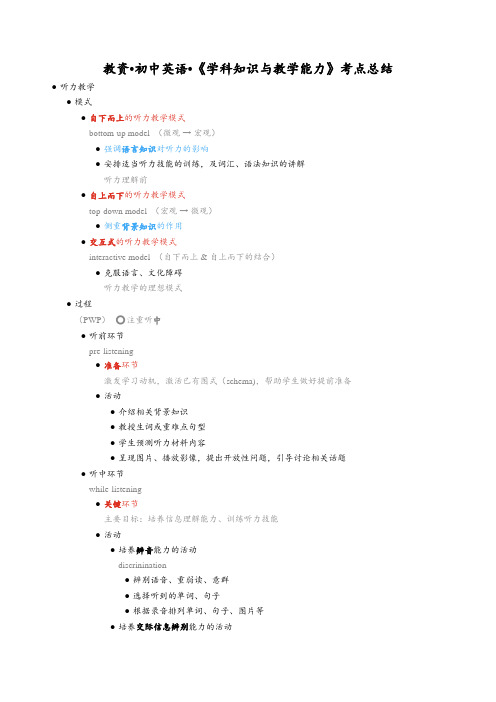
教资•初中英语•《学科知识与教学能力》考点总结●听力教学●模式●自下而上的听力教学模式bottom-up model (微观→ 宏观)●强调语言知识对听力的影响●安排适当听力技能的训练,及词汇、语法知识的讲解听力理解前●自上而下的听力教学模式top-down model (宏观→ 微观)●侧重背景知识的作用●交互式的听力教学模式interactive model (自下而上 & 自上而下的结合)●克服语言、文化障碍听力教学的理想模式●过程(PWP)⭕注重听中●听前环节pre-listening●准备环节激发学习动机,激活已有图式(schema),帮助学生做好提前准备●活动●介绍相关背景知识●教授生词或重难点句型●学生预测听力材料内容●呈现图片、播放影像,提出开放性问题,引导讨论相关话题●听中环节while-listening●关键环节主要目标:培养信息理解能力、训练听力技能●活动●培养辨音能力的活动discrinination●辨别语音、重弱读、意群●选择听到的单词、句子●根据录音排列单词、句子、图片等●培养交际信息辨别能力的活动identify communication signals●识别对话中的新信息指标语、例证指示语、话题中止语、话题转换指示语等●培养大意理解能力的活动listen for the gist ( 宏观角度 )●理解对话或独白的主题、意图、大意●听录音,判断听前预测是否正确●培养细节理解能力的活动listen for specific information ( 微观角度 )●获取具体信息●培养推理判断和预测能力的活动infer and predict●根据语气、对话内容,推断说话人的意图、态度、说话人之间的关系、预测下文●推测个别表达的作用、代词的指代内容、说话人的身份和态度、对话发生的时间和地点、接下来的情节●培养词义猜测能力的活动guess word meaning●猜测听力材料中出现的陌生表达方式含义●培养记笔记能力的活动take notes●根据听力材料的类型、要求,用简单的符号、数字、有代表性的字母记录所听信息●注意●精听careful listening●通过听材料,把材料内容感知一遍,加深学生对材料细节内容的理解●泛听extensive listening●初步听材料并回答问题,初步了解文章的主旨大意和基本内容●听后环节post-listening●作用:巩固与深化加工重组型信息,加深理解●活动●重要的生词和语法作解释和扩展帮助巩固和拓展所学知识●针对听力材料多角度提问●跟读听力、复述听力材料内容、讨论相关话题●编创对话、角色扮演,培养合作意识●培养想象力、书面表达能力●培养批判思维●评价对话或语篇中事件或说话人的做法●体会对话或语篇背后隐含的意义●策略●培养学生良好的语感●培养语音感觉●培养语意感觉●培养对语言感情色彩的感觉●培养学生良好的听力习惯●听前环节浏览信息●边听边记录,边听边记忆●遇到无法听懂的词句,继续听下去●营造轻松的听力氛围●缓解压力,增强信心●口语教学●内容●语言形式language form●语言内容language content●(交际)功能functions●(文化与交际)策略strategies●原则●平衡流利性与准确性●口语要流利、准确流利:语言顺畅、意义完整表达准确:语音形式正确使用●模仿性口语●及时纠错●交际性口语●允许错误的发生,尽量不打断学生的思路●情境化原则●针对不同教学内容,创设贴近学生生活经历的话语情境●真实性、可操作性,培养跨文化交际的意识和能力●激励性原则●尽可能多的为学生开口说英语创造机会●克服紧张、害怕出错的心理,及时加以肯定和鼓励,及时表扬●信息沟原则●信息沟(information gap):不同人掌握信息方面存在的差距也叫信息不对称●由于这种差距,人们才有了交际活动●调查survey●讨论discussion●采访interview●发展口语策略原则●加强口语策略的讲解和训练●策略:引出话题、维持交谈、转移与终止话题、引起注意、表示倾听和理解、插话、回避、转码、释义、澄清、求助●听说结合原则●增加语言知识类的语言输入●积累话题的素材●活动多样化原则●兴趣、主动性、参与性●过程( PWP )●说前环节pre-speaking●首要任务:让学生明确口语活动的话题●活动●头脑风暴、阅读材料减少学生的表达障碍●播放语口语活动相关的听力材料了解话题,积累语言素材●说中环节while-speaking●任务注意●学生:在规定的时间内完成口语活动●教师:巡场●活动:要有梯度(简单→ 难)●活动●控制性和机械性活动controlled or mechanical activities●扩展句子expand sentences●朗读read aloud●模仿imitate●复述retell●听写dictate●翻译translate●背诵recite●半控制性或半机械性活动semi-controlled or semi-mechanical activities●情景对话situational conversation●图片描述describe pictures●开放性和创造性活动open or creative activities●涉及信息相互传递,围绕某一话题/问题,以结对/ 小组合作的方式开展●活动●采访interview●调查survey●自由交谈free talk●猜谜游戏guessing game●小组讨论group discussion●角色扮演role-play●辩论debate●即兴演讲impromptu speech●说后环节post-speaking●安排展示和评价活动,帮助学生纠正错误●阅读教学●模式●自上而下的模式top-down m model (宏观→ 微观)●重视背景知识导入,运用自己的知识对文章的下文进行预测●优点●着眼于从整体上把握文章,培养学生的速度能力●缺点●不利于积累和掌握基础语言知识●自下而上的模式bottom-up model (微观→ 宏观)●对材料的理解:从比较小的语言文字单位到比较大的单位●过程:“刺激-反应-强化”阅读,是各项基本的阅读能力的培养和强化●优点●更注重细节●缺点●不利于阅读速度的提升●不能从更高的角度理解文章的深层含义●交互补偿的模式interactive compensatory model●是以上两种模式的结合●过程( PWP )⭕注重读中●读前环节pre- reading●激发阅读动机,激活背景知识,减少阅读障碍,做好阅读准备●活动●呈现图片、视频、标题、谜语,预测阅读材料的主题、语境/ 主要内容●教授重点单词、短语、句型●呈现标题、图片、播放视频,介绍阅读材料的背景知识●提出开放性问题●读中环节while-reading●阅读为主,帮助理解阅读材料,训练阅读技能●活动●判断预测是否正确,总结文章大意或段意,给阅读材料拟定标题●找到事实性问题的答案,判断正误,提取信息,完成表格,补全句子,将材料中的事件进行排序●读后环节post-reading●开展评价性和应用性活动,巩固和拓展知识●活动●学生评估自己阅读过程中的表现●根据一定的线索(如:思维导图)复述材料内容,加深阅读材料的理解和记忆●角色扮演●采访活动,调查活动,讨论活动●教师指导学生进行写作,提升书面表达能力●学生对故事类语篇进行简单的续编●制作展板/ 海报,培养创作和动手能力●基本技能●略读/ 跳读skimming●尽可能快的速度,有选择的阅读,跳过某些细节,只抓住文章大意●可着重关注起始段和结尾段、段落的主题句、与主题句相关的信息、标题、架构●寻读/ 查读scanning●通过快速阅读,在文字资料中查询特定的细节信息,带有明确的目的性●利用关键词、小标题、图片、表格等快速定位●猜测词义word-guessing●扩大词汇量的有效方法●利用上下文、同义词、反义词、构词法●预测predicting●借助标题、图片等信息,对文章题材、题材、结构脉络、内容等进行预测文章体裁:记叙文、说明文、议论文题材:经济、政治、历史、文化、科普●推理inferring●透过表面意思,领悟言外之意、语气、态度●识别指代关系recognizing the reference●分析、判断、整体阅读、归纳和总结●策略●泛读与精读相结合●阅读与说、写相结合●阅读是一种语言输入,最终应转化为语言输出●激发学生阅读兴趣●阅读材料:趣味性●阅读任务:多样性、丰富性●不同文体侧重不同要点●布置不同的阅读任务●写作教学●模式●重结果product-oriented approach●注重写作成品●重过程process-oriented approach●写作内容与写作过程并重●重内容content-oriented approach●强调写作内容的丰富性主张通过不同渠道收集素材,丰富写作内容●过程( PWP ) ⭕注重写前●写前环节pre-writing●激发写作动机,帮助积累素材,明确写作思路和文章结构(格式),为初稿写作做准备(语言形式、语言结构,词、句型)●活动●头脑风暴brainstorming●讨论或调查discussion/ survey●分析范文analyzing the sample article●绘制思路图/ 思维导图drawing a mind map●用途●可以帮助学生记录并整理思路●学生:组织学习内容,整理知识框架,提升学习效率●教师:制定教学计划,整理教学设计,展示教学内容,提升教学效率●注意事项●相关性●灵活性●适度性●写提纲drawing up an outline●写中环节while-writing●要求:注意检查单词,拼写标点,句子表达,文章结构,时间,内容,主题●写后环节post-writing●对初稿进行推敲、润色、修改、评析、分享●活动●自改与互改self-editing and peer-editing●修订revising●对文章进行修改完善●分享和评价sharing and evaluating●邀请几名学生分享自己的文章,并给予评价●形式●控制性写作controlled writing (重复、机械、练习)●抄写copying●填空blank-filling●完成句子completion●句型转换transformation●造句making sentences●指导性写作guided writing (限制)●段落写作●摘要性写作●基于调查问卷的写作●表达性写作expressive writing (开放性)●随意写作●学生可以随意写他们想写的任何事情●叙述和描述细节●语言水平高的学生,可以根据他们所熟悉的主题写一些小文章●原则●模仿性与应用性相结合●重过程与重结果相结合●写作与听说、阅读有机结合●学习性写作和交际性写作相结合。
英语学科知识与教学能力简单题答题技巧汇总

1.比较视听法(Audio-Visual Method)和听说法(Audio-oral method)的特点及其优缺点。
P1502.语音教学有哪些内容?选其中两个说明其教学方法。
P180(1)语音层次的语音教学音标教学和读音规则教学(2)语流层次的语音教学句子重音(Stresses of sentences)节奏rhythms意群和停顿(Sense group and pause)连读和失去爆破(Liaison and loss of plosion)语调(Intonations)(3) 训练学生的重读1.听录音,看材料,思考为何需要重读2.让学生理解何时用重读之后进行训练(4) 训练学生的语调1.让学生意识到一个词可以表达不同的意义和语气。
2.让学生通过通录音总结何时用升调,何时用降调3.简述词汇教学的内容,说明两种词汇教学模式P184(1)内容:①词义(Meaning)包括概念意义(Denotative meaning)和关联意义(connotative meaning)②词法(Basic information)包括词类、词缀、拼写及发音③用法(Usage)包括词汇的搭配、短语、习语、风格、语域④词汇学习策略(Strategies)(2)教学模式①PPT模式, 由Presentation(呈现).Practice(练习).Testing(测试)三个阶段组成。
a.呈现:教师借助实物、图片、视频、行为等方式呈现单词的意义和用法。
b.练习:通过匹配、替换、表演、猜测、词汇接龙等练习活动,训练和巩固所学词汇。
c.测试:设置语境运用所学词汇,或者设计活动了解学生对词汇音、形、义的掌握程度。
②TBLT模式TBLT(Task-Based Language Teaching)模式要求词汇教学中应按照任务型教学的原则设计与词汇相关的任务。
按照任务型教学的原则,词汇学习不只是了解单词的意义与功能,更重要的是利用词汇完成阅读、听力和写作的任务。
(完整版)初中英语学科知识与教学能力试题及答案

《英语学科知识与教学能力》(初中)一、考试目标1.英语学科知识与能力具有扎实的英语语言基础知识和语言能力;具备从事初中英语教学所需要的英语语言能力;能理解有关英语国家的语言、历史和文化等相关知识。
2.英语学科教学知识与能力掌握外语教学基本理论、英语教学专业知识与国家英语课程标准内容等学科教学知识,并能用以指导初中英语教学。
3.英语学科教学设计能力能够根据英语学科特点,针对初中学生的认知特点、语言水平和学习需要选择并设计合理的教学内容,形成完整合理的教学方案。
4.英语学科教学实施能力理解初中英语课堂教学实施的基本原则和方法,具备实施语言课堂教学的基本能力;能够根据教学设计,结合教学实际情况,采用恰当的教学手段,引导学生进行有效学习。
5.英语学科教学评价知识与能力了解初中英语课堂教学评价的基本知识和方法,能够对学生的语言学习进行恰当的评价;了解教学反思的基本方法和策略,能够对自己的课堂教学实践进行反思,提出改进的思路。
二、考试模块内容与要求(一)语言知识与能力1.掌握英语语言的基础知识,了解语言研究中与英语教学相关的基本概念和知识,并能在课堂教学中加以运用。
2.具有良好的英语语言运用能力,包括用英语进行书面表达、获取教学资源和信息、表达思想情感和与学生良好沟通的能力;能够筛选并改编适合初中学生英语水平的语言材料。
3.能够在语篇中理解英语国家的语言、历史和文学等相关的社会文化知识。
(二)语言教学知识与能力1.了解外语教学基本理论,理解语言观、语言学习观、语言教学观等对初中英语教学的指导作用。
2.理解《义务教育英语课程标准(2011年版)》的目标内容(语言技能、语言知识、情感态度、学习策略和文化意识),以及课程标准的其他相关知识,并能在教学设计与实施中运用。
3.掌握英语语言知识(语音、词汇、语法、语篇等)的教学基本原则、讲解和练习方法。
4.掌握英语语言技能(听、说、读、写)的教学原则和训练方法。
5.能结合中外社会文化语境,设计并实施英语知识和技能的教学与训练。
(完整版)英语学科知识与能力考试简答题汇总,推荐文档.doc

英语学科知识和能力简答题根据目要求完成下列任,用中文作答。
1.堂入是初中英堂教学常用的步之一。
以文“Christmas ” 例,写出四种常的入方法并各一例明。
(1)歌曲入法“同学,你今天开心 ?我看大家都非常有精神,的状很不。
那在上之前,老先大家播放一首歌曲 Marry Christmas ,如果会唱的,你可以跟着拍一起唱,好 ?( 播放歌曲 ) 同学,歌曲听完了,大家得首歌曲熟悉 ?⋯⋯,非常不,首歌曲是在唱圣。
老有个:你知道圣的来 ?⋯⋯好多同学都不是很清楚,那么今天老将大家一起走圣,在英的海洋中一起感受圣的快。
”(2)片入法“ How are you .bovs and girls? 同学好,很高再次到大家。
今天的老来了几幅片,在大家看大屏幕,从第一幅中,大家看到了什么?⋯⋯,是我都非常熟悉的圣老人,大家的反速度真快。
在看第二幅,大家看到了什么呢?我听到有同学圣、圣袜,噢,有色的圣帽,大家察得非常仔。
那么在老有一个了,你知道什么圣要放圣,并戴圣帽?圣老人又是从哪里来的呢 ?着些,我一起走今天的堂,来学与圣相关的知。
”(3) 入法“同学,在今天上之前,大家先看一段。
( 播放 ) 束了,同学, What can you see in this video? 你看到了什么 ?好的,我听到有同学看到了圣老人着雪橇在挨家挨地送礼物,有的同学看到了艾米一家在准圣晚会。
大家察得都非常仔,那同学有没有思考一个,你知道圣是怎么来的?看来大家都不知道。
没关系,那么我今天就一起来学新的一——圣,从而找到个答案。
”(4)故事入法“同学,每年的 12 月 25 13 很多西方国家都会一个于他来特重要的日——圣。
也就是英文的 Christmas 。
在那一天,大街上非常,大人和小孩会穿着日的盛装穿梭于大街小巷。
可是,同学,你知道每年的12 月 25 日是全世界基督教徒念耶生的日子?大家一茫然,看来不是很清楚,没关系,那么我今天就一起来学新的一——圣,从而找到个答案。
中学教师资格认定考试(初级英语学科知识与教学能力)-试卷21
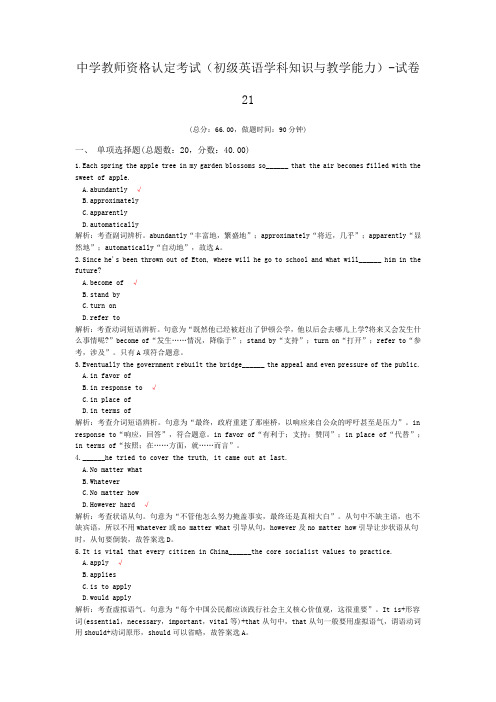
中学教师资格认定考试(初级英语学科知识与教学能力)-试卷21(总分:66.00,做题时间:90分钟)一、单项选择题(总题数:20,分数:40.00)1.Each spring the apple tree in my garden blossoms so______ that the air becomes filled with the sweet of apple.A.abundantly √B.approximatelyC.apparentlyD.automatically解析:考查副词辨析。
abundantly“丰富地,繁盛地”;approximately“将近,几乎”;apparently“显然地”;automatically“自动地”,故选A。
2.Since he's been thrown out of Eton, where will he go to school and what will______ him in the future?A.become of √B.stand byC.turn onD.refer to解析:考查动词短语辨析。
句意为“既然他已经被赶出了伊顿公学,他以后会去哪儿上学?将来又会发生什么事情呢?”become of“发生……情况,降临于”;stand by“支持”;turn on“打开”;refer to“参考,涉及”。
只有A项符合题意。
3.Eventually the government rebuilt the bridge______ the appeal and even pressure of the public.A.in favor ofB.in response to √C.in place ofD.in terms of解析:考查介词短语辨析。
句意为“最终,政府重建了那座桥,以响应来自公众的呼吁甚至是压力”。
in response to“响应,回答”,符合题意。
教资高中英语简答题知识点

教资高中英语简答题知识点包括但不限于以下内容:
教育教学方面:
多样性:课程设置应丰富多彩,满足不同学生的需求。
灵活性:教学方法应灵活多样,根据不同的教学内容和学生的
学习情况,采用不同的教学方法。
相关性:教育教学应与学生的实际生活和周围环境相关联,帮
助学生更好地理解和应用所学知识。
学生方面:
以学生为主体:教育教学应以学生为主体,充分发挥学生的主
观能动性。
全员参与:鼓励学生全员参与课堂活动,激发他们的学习热情。
因材施教:根据学生的不同特点和需求,采用不同的教学策略,以最大限度地发挥每个学生的潜力。
学以致用方面:
理论与实际相结合:教育教学应将理论与实际相结合,帮助学
生更好地理解和应用所学知识。
培养学生分析问题、解决问题、综合应用语言的能力:教育教
学应注重培养学生的实际语言应用能力,包括口语、阅读、写作和
听力等方面。
作用用途类(工具/手段/方法):
提升教师授课/备课效率:教师需要采用有效的策略和方法来提高授课和备课的效率。
提升学生学习效率:学生需要采用有效的学习方法来提高学习效率。
与教学环节相关:如备课要素中的应用,授课环节(PWP),不同课型(阅读,写作)等。
与活动主体相关:如学生兴趣的培养、良好师生关系的建立,教师进行教学检验、提高教学水平、促进教师间交流、促进自主学习、提高工作乐趣等。
希望以上内容可以帮助您备考教资高中英语简答题。
教师资格证考试中学英语学科知识与教学能力试题及答案

考前须知:1.考试时间为120分钟,总分值为150分。
2.请按规定在答题卡上填涂、作答。
在试卷上作答无效,不予评分。
一、单项选择题(本大题共30小题,每题2分,共60分)在每题列出的四个备选项中选择一个最正确答案,请用28铅笔把答题卡上对应题目的答案字母按照要求涂黑。
错选、多项选择或未选均无分。
1. Which of the following words does not contain a fricative?A. fiveB. changeC. showD. three2. Decide on the correct stress pattern of the answer to the question: When shall we go to school?A. I think we should leave at seven o'clock.B. I think we should leave at seven o'clock.C. I think we should leave at seven o'clock.D. I think we should leave at seven o'clock.3. Everyone must have liked the cake because there wasn't even a __________left.A. crutchB. chipC. chopD. clip4. Operations which left patients __________and in need of long periods of discovery time now leave them feeling relaxed and comfortable.A. unhealthyB. exhaustedC. fearfulD. upset5. The world market is__________ changing. We must anticipate the changes and make timely adjustments.A. stablyB. constantlyC. scarcelyD. occasionally6. In the cinema, there was an old man __________beside me.A. atB. sitC. sittingD. to sit7. The engineers are so busy that they have zero time for outdoor sports activities,they have the interest.A. whereverB. wheneverC. even ifD. as if8. It is imperative that the government__________more investment into the shipbuilding industry.A. attractsB. shall attractC. attractD. has to attract9. The relationship between "fruit" and "apple" is__________.A. homonymyB. hyponymyC. polysemyD. synonymy10. Which of the following items is not one of the grammatical categories of English pronouns?A. genderB. numberC. caseD. voice11. What's the starting point and destination of English course?A. knowledge impartationB. students' developmentC. language usageD. habit formation12. The classroom teaching environment consists of classroom environment and__________.A. social environmentB. communication environmentC. practice environmentD. game environment13. When a student has something in his mind and he should ignore the irrelevant parts when reading, which of the following strategies can be used?A. skimmingB. detailed readingC. scanningD. predicting14. Students are offered with opportunities to integrate what they learned from the text into their existing knowledge and communicate with others using the information in the listening text. This description belongs to __________ stage.A. pre-listeningB. while-listeningC. post-listeningD. none of them15. Which of the following does not belong to the post-listening activities?A. Multiple-choice questions.B. Answering questions.C. Dictogloss.D. Listen and tick.16. Which of the following belongs to the communicative approach?A. Focus on accuracy.B. Focus on fluency.C. Focus on strategies.D. Focus on comprehension.17. When we praise the children, "you did a very good job! " you can raise your thumb without saying "good". This suitation means that we can understood the meaning by__________.A. spoken languageB. body languageC. spelling languageD. written language18. What role does the teacher play at the feedback stage?A. Assessor.B. Instructor.C. Manager.D. Researcher.19. What vocabulary learning strategy does the following activity help to train?The teacher created a situation and asked students to think of words and expressions that can be used in that situation.A. Association.B. Generalization.C. Collocation.D. Contextualization.20. Which of the following is most suitable for the cultivation of linguistic competence?A. Sentence-making.B. Cue-card dialogue.C. Simulated dialogue.D. Learning syntax. Passage 1Trees should only be pruned when there is a good and clear reason for doing so and, fortunately, the number of such reasons is small. Pruning involves the cutting away of overgrown and unwanted branches, and the inexperienced gardener can be encouraged by the thought that more damage results from doing it unnecessarily than from leaving the tree to grow in its own way.First, pruning may be done to make sure that trees have a desired shape or size. The object may be to get a tree of the right height, and at the same time to help the growth of small side branches which will thicken its appearance or give it a special shape. Secondly, pruning may be done to make the tree healthier. You may cut diseased or dead wood, or branches that are rubbing against each other and thus cause wounds. The health of a tree may be encouraged by removing branches that are blocking up the centre and so preventing the free movement of air. One result of pruning is that an open wound is left on the tree and this provides an easy entry for disease, but it is a wound that will heal. Often there is a race between the healing and the disease as to whether the tree will live or die, so that there is a period when the tree is at risk. It should be the aim of every gardener to reduce which has been pruned smooth and clean, for healing will be slowed down by roughness. You should allow the cut surface to dry for a few hurts and thenpaint it with one of the substances available from garden shops produced especially forthis purpose. Pruning is usually without interference from the leaves and also it is very unlikely that the cuts you make will bleed. If this does happen, it is, of course, impossible to paint them properly.21. Pruning should be done to__________.A. make the tree grow tallerB. improve the shape of the treeC. get rid of the small branchesD. make the small branches thicker22. Trees become unhealthy if the gardener__________.A. allows too many branches to grow in the middleB. does not protect them from windC. forces them to grow too quicklyD. damages some of the small side branches23. Why is a special substance painted on the tree?A. To make a wound smooth.B. To prevent disease entering a wound.C. To cover a rough surface.D. To help a wound to dry.24. A good gardener prunes a tree__________.A. at intervals throughout the yearB. as quickly as possibleC. occasionally when necessaryD. regular every winter25. What was the author's purpose when writing this passage?A. To give practical instruction for pruning a tree.B. To give a general description of pruning.C. To explain how trees develop diseases.D. To discuss different methods of pruning.请阅读Passage 2,完成第26~30小题。
英语学科-简答题、教学情境分析题高频考点汇总
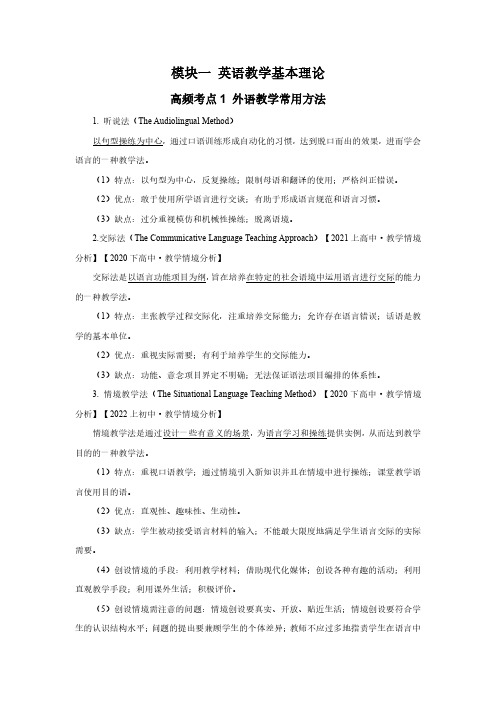
模块一英语教学基本理论高频考点1外语教学常用方法1.听说法(The Audiolingual Method)以句型操练为中心,通过口语训练形成自动化的习惯,达到脱口而出的效果,进而学会语言的一种教学法。
(1)特点:以句型为中心,反复操练;限制母语和翻译的使用;严格纠正错误。
(2)优点:敢于使用所学语言进行交谈;有助于形成语言规范和语言习惯。
(3)缺点:过分重视模仿和机械性操练;脱离语境。
2.交际法(The Communicative Language Teaching Approach)【2021上高中·教学情境分析】【2020下高中·教学情境分析】交际法是以语言功能项目为纲,旨在培养在特定的社会语境中运用语言进行交际的能力的一种教学法。
(1)特点:主张教学过程交际化,注重培养交际能力;允许存在语言错误;话语是教学的基本单位。
(2)优点:重视实际需要;有利于培养学生的交际能力。
(3)缺点:功能、意念项目界定不明确;无法保证语法项目编排的体系性。
3.情境教学法(The Situational Language Teaching Method)【2020下高中·教学情境分析】【2022上初中·教学情境分析】情境教学法是通过设计一些有意义的场景,为语言学习和操练提供实例,从而达到教学目的的一种教学法。
(1)特点:重视口语教学;通过情境引入新知识并且在情境中进行操练;课堂教学语言使用目的语。
(2)优点:直观性、趣味性、生动性。
(3)缺点:学生被动接受语言材料的输入;不能最大限度地满足学生语言交际的实际需要。
(4)创设情境的手段:利用教学材料;借助现代化媒体;创设各种有趣的活动;利用直观教学手段;利用课外生活;积极评价。
(5)创设情境需注意的问题:情境创设要真实、开放、贴近生活;情境创设要符合学生的认识结构水平;问题的提出要兼顾学生的个体差异;教师不应过多地指责学生在语言中出现的错误。
2019年教师资格考试初中英语学科知识与教学能力简答题汇编

2019年初中英语教师资格考试学科知识与教学能力简答题1.课堂导人是初中英语课堂教学常用的步骤之一。
以课文“Christmas”为例,写出四种常见的导入方法并各举一例说明。
[参考答案](1)歌曲导入法“同学们,你们今天开心吗?我看大家都非常有精神,这样的状态很不错。
那在上课之前,老师先给大家播放一首歌曲Marry Christmas,如果会唱的话,你可以跟着节拍一起唱,好吗?(播放歌曲)同学们,歌曲听完了,大家觉得这首歌曲熟悉吗?……对,非常不错,这首歌曲是在欢唱圣诞节。
老师这儿有个问题:你们知道圣诞节的来历吗?……好多同学都不是很清楚,那么今天老师将带领大家一起走进圣诞节,在英语的海洋中一起感受圣诞节的快乐。
”(2)图片导入法“How are you.bovs and girls?同学们好,很高兴再次见到大家。
今天的这节课老师带来了几幅图片,现在请大家看大屏幕,从第一幅图中,大家看到了什么?……对,这是我们都非常熟悉的圣诞老人,大家的反应速度真快。
现在请看第二幅图,大家看到了什么呢?我听到有同学说圣诞树、圣诞袜,噢,还有红色的圣诞帽,大家观察得非常仔细。
那么现在老师有一个问题了,你们知道为什么圣诞节要摆放圣诞树,并戴圣诞帽吗?圣诞老人又是从哪里来的呢?带着这些问题,让我们一起走进今天的课堂,来学习与圣诞节相关的知识。
”(3)视频导入法“同学们,在今天上课之前,请大家先看一段视频。
(播放视频)视频结束了,同学们,What can you see in this video?你们看到了什么?好的,我听到有同学说看到了圣诞老人驾着雪橇在挨家挨户地送礼物,还有的同学看到了艾米一家在准备圣诞晚会。
大家观察得都非常仔细,请给自己鼓鼓掌,好吗?那同学们有没有思考过一个问题,你们知道圣诞节是怎么来的吗?看来大家都不知道。
没关系,那么我们今天就一起来学习新的一课——圣诞节,从而找到这个答案。
”(4)故事导入法“同学们,每年的12月2513很多西方国家都会过一个对于他们来说特别重要的节日——圣诞节。
2023年教师资格之中学英语学科知识与教学能力题库及精品答案

2023年教师资格之中学英语学科知识与教学能力题库及精品答案单选题(共30题)1、请阅读Passage 1。
完成第小题。
A.certain factors that determine the ease with which social changes occurB.certain factors that promote social changeC.the necessity of social changeD.two different societies【答案】 A2、Which of the following words does NOT have a suffix?A.NorthwardB.SnowyC.HappyD.Worker【答案】 C3、David has tried 3 times to repair the clock.He willtry__________time after having a rest.A.fourB.fourthC.the fourthD.a fourth【答案】 D4、Which of the following statements is NOT a way of presenting new vocabularyA.Defininging real objectsC.Writing a passage by using new wordsD.Giving explanations【答案】 C5、For more advanced learners, group work may be more appropriate than pair work for tasksthat are __________.A.linguistically simpleB.structurally controlledC.cognitively challengingD.thematically non-demanding【答案】 C6、What should you think about in trying to find your career? You are probably better at some school subjects than others. These may show strengths that you can use in your work. A boy who is good at mathematics can use that in an engineering career. A girl who spells well and likes English may be good at office work. So it is important to know the subjects you do well in at school. On the other hand, you may not have any specially strong or weak subjects but your records show a general satisfactory standard. Although not all subjects can be used directly in a job, they may have indirect value. A knowledge of history is not required for most jobs but if history is one of your good subjects you will have learned to remember facts and details. This is an ability that can be useful in many jobs.A.The importance of doing well at schooling school performance to help to choose a careerC.The importance of being good at all subjectsD.The indirect value of schoolwork【答案】 B7、请阅读Passage l。
中学教师资格认定考试(初级英语学科知识与教学能力)-试卷19

中学教师资格认定考试(初级英语学科知识与教学能力)-试卷19(总分:66.00,做题时间:90分钟)一、单项选择题(总题数:20,分数:40.00)1.The man' s______was described as impatient in contrast to his wife' s.A.character √B.personalityC.natureD.property解析:考查近义词辨析。
character尤指品性,品质方面的“性格”,指一个人所特有的、与他人不同的特性、特征。
它决定一个人对待生活中重大问题的态度。
例句:His character is very different from his wife’s.他和他妻子的性格迥然不同。
personality多指为人处事方面与众不同的“个性、风度”,尤指能感染人的性格特征。
例句:His personality left a deep impression on us.他的个性给我们留下了深刻的印象。
nature指天生的、无法改变的性格或品质;property专指某物所固有的、真正的、本质特性,属性,一般不用于指人。
故此题选A。
2.You should take the part a good way of learning______in your study into consideration.A.actsB.enjoysC.plays √D.forms解析:考查固定搭配。
此句中固定结构play a part in意为“起作用”,句意为“你应该经常考虑一下好的学习方法在你学习过程中起的作用”。
3.It is not I but you who______the first to run to the goal in that competition.A.amB.wasC.isD.are √解析:考查主谓一致。
not…but…“不是……而是……”,连接两个主语,谓语动词为就近原则,这里离它较近的主语是you,故用复数。
教资英语科三简答题汇总
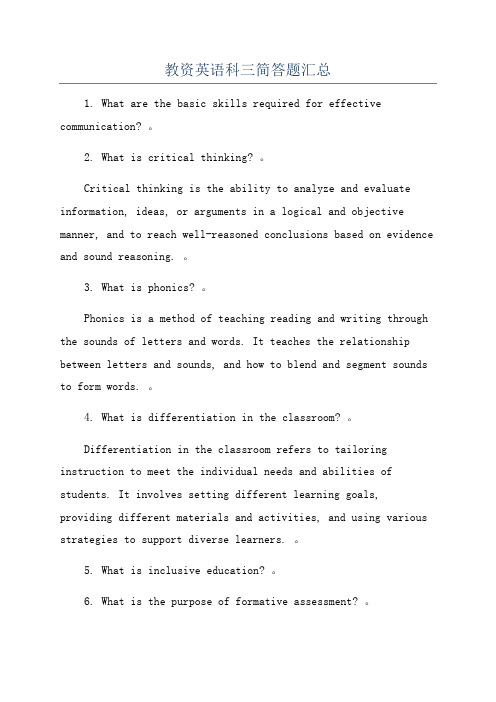
教资英语科三简答题汇总1. What are the basic skills required for effective communication? 。
2. What is critical thinking? 。
Critical thinking is the ability to analyze and evaluate information, ideas, or arguments in a logical and objective manner, and to reach well-reasoned conclusions based on evidence and sound reasoning. 。
3. What is phonics? 。
Phonics is a method of teaching reading and writing through the sounds of letters and words. It teaches the relationship between letters and sounds, and how to blend and segment sounds to form words. 。
4. What is differentiation in the classroom? 。
Differentiation in the classroom refers to tailoring instruction to meet the individual needs and abilities of students. It involves setting different learning goals, providing different materials and activities, and using various strategies to support diverse learners. 。
国考教师资格证英语简答题知识点梳理
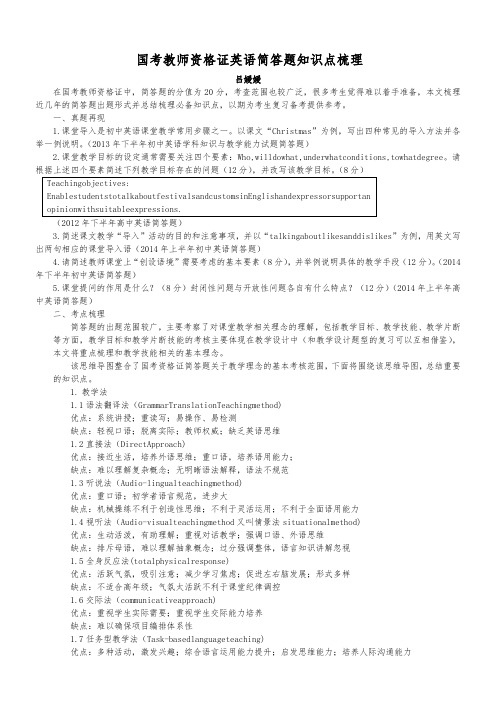
国考教师资格证英语简答题知识点梳理吕媛媛在国考教师资格证中,简答题的分值为20分,考查范围也较广泛,很多考生觉得难以着手准备,本文梳理近几年的简答题出题形式并总结梳理必备知识点,以期为考生复习备考提供参考。
一、真题再现1.课堂导入是初中英语课堂教学常用步骤之一。
以课文“Christmas”为例,写出四种常见的导入方法并各举一例说明。
(2013年下半年初中英语学科知识与教学能力试题简答题)2.课堂教学目标的设定通常需要关注四个要素:Who,willdowhat,underwhatconditions,towhatdegree。
请根据上述四个要素简述下列教学目标存在的问题(12分),并改写该教学目标。
(8分)Teachingobjectives:EnablestudentstotalkaboutfestivalsandcustomsinEnglishandexpressorsupportanopinionwithsuitableexpressions.(2012年下半年高中英语简答题)3.简述课文教学“导入”活动的目的和注意事项,并以“talkingaboutlikesanddislikes”为例,用英文写出两句相应的课堂导入语(2014年上半年初中英语简答题)4.请简述教师课堂上“创设语境”需要考虑的基本要素(8分),并举例说明具体的教学手段(12分)。
(2014年下半年初中英语简答题)5.课堂提问的作用是什么?(8分)封闭性问题与开放性问题各自有什么特点?(12分)(2014年上半年高中英语简答题)二、考点梳理简答题的出题范围较广,主要考察了对课堂教学相关理念的理解,包括教学目标、教学技能、教学片断等方面,教学目标和教学片断技能的考核主要体现在教学设计中(和教学设计题型的复习可以互相借鉴),本文将重点梳理和教学技能相关的基本理念。
该思维导图整合了国考资格证简答题关于教学理念的基本考核范围,下面将围绕该思维导图,总结重要的知识点。
教资高中英语科三简答题汇总
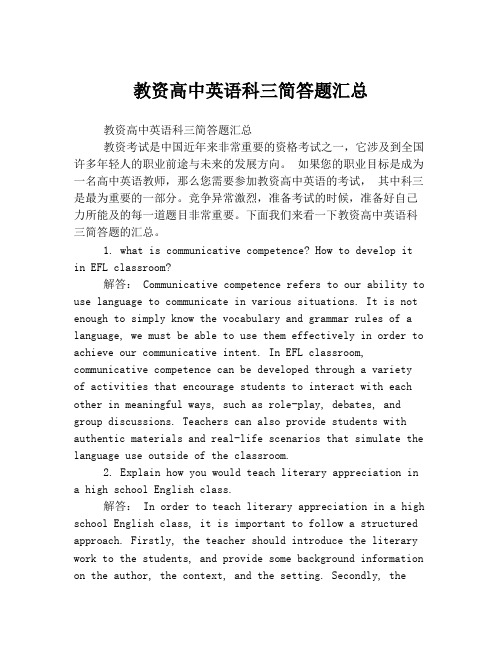
教资高中英语科三简答题汇总教资高中英语科三简答题汇总教资考试是中国近年来非常重要的资格考试之一,它涉及到全国许多年轻人的职业前途与未来的发展方向。
如果您的职业目标是成为一名高中英语教师,那么您需要参加教资高中英语的考试,其中科三是最为重要的一部分。
竞争异常激烈,准备考试的时候,准备好自己力所能及的每一道题目非常重要。
下面我们来看一下教资高中英语科三简答题的汇总。
1. what is communicative competence? How to develop itin EFL classroom?解答: Communicative competence refers to our ability to use language to communicate in various situations. It is not enough to simply know the vocabulary and grammar rules of a language, we must be able to use them effectively in order to achieve our communicative intent. In EFL classroom, communicative competence can be developed through a varietyof activities that encourage students to interact with each other in meaningful ways, such as role-play, debates, and group discussions. Teachers can also provide students with authentic materials and real-life scenarios that simulate the language use outside of the classroom.2. Explain how you would teach literary appreciation ina high school English class.解答: In order to teach literary appreciation in a high school English class, it is important to follow a structured approach. Firstly, the teacher should introduce the literary work to the students, and provide some background information on the author, the context, and the setting. Secondly, theteacher should guide students to build their basic reading strategies, such as recognizing literary devices, understanding the plot, and analyzing the characters. Then, the teacher can encourage the students to make connections between the text and the real world and relate it to their own experiences. Finally, students can be encouraged to express their own opinions, feelings, and reactions towards the literary works through discussion, presentation, or writing assignments.3. Explain how you would differentiate instruction for a high school English class with students of varying levels.解答: In order to differentiate instruction for a high school English class with students of varying levels, the teacher can adopt several strategies. Firstly, the teacher should assess the students' proficiency levels accurately and form heterogeneous or homogeneous groups. Secondly, the teacher can adjust the instructions or materials based on the needs or pace of the students, such as providing extra resources or challenging tasks for advanced students, and slowing down or simplifying the instructions for lower-level students. Thirdly, the teacher can use different teaching methods or modalities, such as lectures, class discussion, cooperative learning, or interactive multimedia to cater to different learning preferences and styles. Finally, the teacher can provide feedback or use formative assessment to monitor the progress of the students and adjust the instructions accordingly.4. Explain your understanding of Bloom's taxonomy and how you would use it in lesson planning.解答: Bloom's taxonomy is a hierarchical classification system of cognitive skills designed to facilitate educatorsin creating objectives and assessments that promote higher-level thinking skills. The taxonomy comprises six different levels of cognitive thinking which are knowledge, comprehension, application, analysis, synthesis, and evaluation. For example, knowledge refers to the recall of information, comprehension refers to the understanding of information, and application refers to using the information to solve problems.As a teacher, I would use Bloom's taxonomy to plan my lessons by setting specific objectives that relate to different levels of cognitive skills, and then designing various activities or assessments to evaluate the students' learning at each level. For instance, I could begin a lesson by asking students to recall information from previous lessons or reviewing some basic skills, and then gradually move towards more complex tasks that require analysis, synthesis, or evaluation. By using Bloom's taxonomy to structure my lessons, I can better challenge students to reach their full potential, and improve their higher-order thinking skills.在备考教资高中英语考试时,掌握简答题的答题技巧非常重要。
- 1、下载文档前请自行甄别文档内容的完整性,平台不提供额外的编辑、内容补充、找答案等附加服务。
- 2、"仅部分预览"的文档,不可在线预览部分如存在完整性等问题,可反馈申请退款(可完整预览的文档不适用该条件!)。
- 3、如文档侵犯您的权益,请联系客服反馈,我们会尽快为您处理(人工客服工作时间:9:00-18:30)。
、拓展延伸法 巧妙设计课外活动题,拓宽视野,提升能力。新课程
养。 因此教师可以在课后小结时
如用英语描述制作粽子和用英 语表达
并且让学生在下节课上进行比赛。 很多学生通过
了答案,虽然这些内容并不是书本上的知识,但
、发散式小结 教师在帮助学生梳理完知识点后根据课文内容提出疑
要立即纠正,使其在学习之初就注重单
发音错误、就
、在教学中为达到准确性,课堂上需要解释话题内容所涉及到的语
则。例如:讲到英文如何表达礼貌时,可以向学
实的遥远,因此可以实
,这样可以增 强学生对文化差异的理解。
4 / 8
使学生积极参与到活动中,
答:
、情境教学是指创设含有真实事件或真实问题的情境,学生在探究
语言教学的策略有哪些,辩音训练及重音、语调训练的内容是什
:
、语音教学的策略 采用多样化手段 提高多样化教材 在情境中进行
让学生接触不同口音
、对辩音训练及重音、语调训练的认识 辩音训练: 辩音练习主要
是提高学生听力 的基
soap---soup,pen----ben ;判
---red(same),rain---lane(different);找出一组词中读音不同的词:
过程中,教师要帮助学生发现问题、分析问题和解决问题。
答:
、流利性和准确性没有清晰的界线,流利性和准确性是一个动态过
要根据学生个 人的特点和学习环境的不同而有所权重。 一方面,
识、结构。另一方面,教
使学生最终达到流利、准确的口语 表
例如: 在单词的教学过程中, 要让学生模仿录音, 当学
阔,
所以他们会提出各种话题如“保护地球”等,
之前所学文章的内容,
同时也锻炼了他们的表达能力以及合作能
请具体说出两种课堂 总结形式
(一) 课堂总结是课堂教学的最后阶段, 课堂总结
归纳总结的过程 (二)课堂总
、可以及时对所讲授的知识加以总结、整理
、进一步深化概念、规律、反馈教学信息
对不同的教学内容和教学对象确定不同的导入方式。
、具有新颖性 新时代的高中学生不仅富有强烈的好奇心,而且具有
有时代性的信息更加能够引起学
课堂教学的效果就会越 好。
阅读巩
答:常用方法有:
、控制性及半控制性练习 机械练习中,学生在某一特定话题下,通
言结构
、自由实际运用阶段 这一阶段不仅要学生说出一些话语, 更主要
练习中,以什
要多少时间,语言输出阶段需要多少时间,用多少时间进
决定的。 角色 3:参与者 教师
2 / 8
关系,为学生创设轻松和真实的交
为了了解
二是为了帮助学生解决讨论中的困难。 三是提醒
快速度,检查进度快的同学讨论是否符合要求,并
角色 4:鼓励者 作为学生的帮助者,
教师只有在学生交流出现明显障碍、表达有困难时适时地 提
确、更改的认识,
而且也能帮助学生形成良好的语言学习习惯,
高表达能力。 方法:教师在纠错时,不仅要区分错误类型、性质,
者相关的各种因素,如年龄、修
方法,
直接纠错是指学习者出
教师打断其语言训练或实践活动, 对其错误予以下面 纠
。这种纠错方法常用于
语言形式而进行的机械操练或侧重语言输出
7 / 8
过程中自主地理解知识、建构意义。情景教学中
与学生的生活密切相关,
,要求教师通过各种手段创设具有一定 感
、原则: 具有趣味性。教学的起点,首先在于激发学生学习的兴趣
味性,学生就会体会到学习是一种精
具有针对性。导入目的就是为了调动
学生明确课堂教
为新课呈现埋下伏笔,因此,教师在进行课堂导入时,
过多的生词和过难的语法项目又会
难影响英语阅读的积极性
、如何把握选用阅读材料的生词量和语法难易度: 不同类型的阅读
一般来说, 作为精读廛阅读语篇的生
一般能力有效阅读词汇总量的 3%,作为泛读课阅读语篇的生
量的 1%。如果教材的词问题过大,
教师应该在教学中适当的讲解生词,以便降低阅 读的生词量,
检查 学生的一堂课学习是否
主要看学生的语言应用能力, 即看学生是否能够运用本节课
知识表达意思及接受词意。 这一要求符合任务教学要求。 威利
型课堂教学模式:任务前(相关情境
真实运用)
5 / 8
、巩固设计 老师可以放一段视频, 完整演绎地球历史, 让学生更
在看完视频之后,结合文章的
堂。因为课堂的结束并不是完结,而
可帮助老师
能力?
、审时度势,注意适时性。课堂提问需要教师审时度势,吸引学生
活跃的教学氛围。
、明确目的,具有针对性。课堂提问必须符合教学目标的需要,同
提问内容的难易程度,学生的年龄征,知识基础
6 / 8
、循循善诱,注意启发性。教学是一个由浅入深,不断提高的过程。
成法和转化法。 派生法主要让学
合成法主要是让学生掌握两 个或两
转化法主要是让学生掌握同
改变其拼写形式的基础上,由一种词性转化为另
water(v.浇水);lift(v.举起 n.
last(adj.持续的 v. 持续)
、读音规则记忆法 老师在教单词的时候可以让学生了解字母及字母
引导学生将单词的音 和形结合起来,通过不断的
帮助教师 改进教学。 形成性评价还包括学生相互评价和
它伴随着整个英语教学 过程。对英语教学起
英语教学过程中之所以以形成性评价为主,
、在英语教学中实施形成性评价 有利于激发和培养学生学习英语的
、调动全体学生的积极性, 使每一个学生都能参与到教学的各个环
3.创造一种紧张而又活跃的课堂气氛,从而 帮助学生树立
这样才能消除学生紧张、焦虑、急躁、恐惧
效果。
答:
、任务前角色 1:任务的设计者 教师作为任务的设计者, 在布置
与教学内容的 关系以及学
教学准备的内容应该包括与教学相关的一切内容, 其中
任务的准备。这是学生能否通过教学活动获得运用英
、任务中 角色 2:课堂控制者 教师作为课堂活动的控制者,决定
、适当肯定,反馈激励性。学生每次回答问题后,教师都应给予其
激励其取得更大的进步。 提问能提高学生的能
课堂提问可以培养学生的思维能力和沟通表达能力。 课堂提问
从而引发学生积极思考,引导学生思维的方向,
高思维的深度。同时,在与教师和其他学生探
与他人交流、沟通表
意义:纠错是指教
导和帮助的一种方式。正确巧妙的纠错,不
学生可以把课文对话录制下来反复听和模
还可以把自己的口头作文复核录下来,仔细审听,发现问题,
下,就要在班级、学校或其他训练场
以便获得长
、克服紧张、焦虑、急躁情绪,不怕听错、说错、不断苦练。在听
学 生有时害怕听错或说错,往往不敢大胆张口练习。
和实践就难以产生熟练的
会话重在达意,只要达到交流思想的目的,听,说实践就应 该
其次,根据生词的难易度和额度,
词汇的记忆与理解融入听、说、读、写、译等语言活动之中,
提高学习效率。 语法既是英语语言功
又是无语言功能的存在。 教学中教师要根据学生学习的
3 / 8
的难度,让学生在示例中理解和感知语法规则,
在不同的语 言活动中培养语法意识。
“重结果的写作教学模式”和重过程的写作教学模式的含5.培养学ຫໍສະໝຸດ 良好的学习习惯和形成有效的学习策略
、培养学生自 我管理的意识和能力
。帮助发展学生自主学习的能力和合作精神,从而不断提高教育教
形成性评论的方式有多种, 如课堂学
学习档案、 问卷调查、 访谈、家长对学生学习情
8 / 8
—bye—buy—bay 重音、语调训练:意音分为词重音和句重音。两
五种形式:平调、升调、降
在
老师可教给学生哪些记忆单词的方法?请列举
答:
、利用卡片进行记忆 这种方法是将单词整理或写在卡片上, 可供
这种方法的特点是简 单实用并易于携带,不
、构词记忆法 教师可以教给学生记忆英语单词的构词法知识。英语
师要循循善诱地交代说明,从学生的兴趣点切入问
、角度新颖,激发趣味性,要根据教学内容灵活采取提问方式,角
学习的积极性。
、面向全体,注意广泛性。面向全体是指教师提出的每一个问题都
保证全体学生都有时间、有兴趣对问题进行思考。
、逐层递进,关注探究性。问题设计要层层递进,使学生在每个阶
索。
建议需要表达的内容。要充分发挥学生的主观
教师既不可 一味批评学生知识上的缺陷, 态度上的不端正,
使学生失去能动性、 创造性。 角色 5:观
教师需要观察学生的表现以便对小组及个个给予及时、 必要的
悉心观察教学活动 是教师教学、 发展自我能力的一个必经
根据观察的结果, 教师可以对自己的教学内容、 教学能力、
1 / 8
答:
、注意区分和模仿正确的语言语调 在听力训练中,有必要注意和模
截然不同的
cure
kill,nearly 和 yearly 等,因此,从一开始就要注意区分和模 仿
、创造一定的听、说环境 没有一个外语环境或一定的听说条件,是
当然,现代科学为 人们提供了 MP3/MP4
、任务后 角色 6:评估者 教师作为评估者一方面是对学生的表现
另一方面是通过学生的表现对自己做 出评估而达到在教
性,以
答:
、重要性 生词量和语法难易度是衡量语篇可读性的重要指标, 英
讲法的难易度影 响着学生对篇章的理解和语义的构
也影响着学生个体语言能力的发展, 过少的单词和语 法无法
